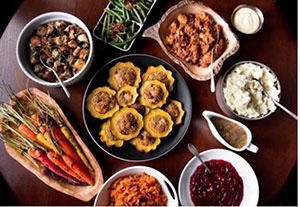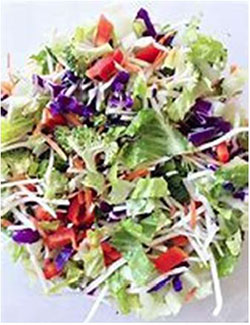Healthy Side Dishes for the Holidays
By: Gisele Jefferson, Family & Consumer Science Extension Agent, Golden Plains Area

While the turkey may be the centerpiece of a holiday meal, it should only take up about a quarter of the plate. This leaves room for several side dishes. Selecting vegetables and fruits for the holiday dinner can be a great opportunity to experiment with colorful fall vegetables and salads. Look at your family favorites, and see if you can reduce the sugar, fats and salt in the recipes to help in making them healthier for your family and guests. You can offer a taste of the season with fewer calories, less cost and less prep time.
- Skip the bacon-wrapped appetizers, and swap them out for a fresh veggie tray, dried fruits or roasted nuts.
- Incorporating fall staples such as nuts and seeds—almonds, pumpkin seeds, pistachios and walnuts, for example—and cooking with canola or olive oil instead of butter will give your health a boost.
- Instead of focusing on saucy side dishes that include butter, sour cream, cheese and canned soups, replace them with savory vegetables like roasted or sautéed colorful vegetables such as carrots, Brussels sprouts, and sweet potatoes.
- A fresh green salad with a sprinkle of sliced apples, dried cranberries and roasted nuts can be so tasty. You can basically eat them to your heart’s content.
When you load up on stuffing and buttered rolls, you might feel well-fed, however, the trillions of beneficial bacteria and other microorganisms living in your gut could still be hungry. When you eat meals high in saturated fat and sugars instead of fruits, vegetables, and whole grains, you can negatively affect your gut health. High-fiber fall vegetables, such as broccoli, Brussel sprouts, cauliflower, cabbage, jicama, red onion, bell peppers, beets, and avocado are especially gut-friendly. A healthy gut is full of microbes that help digest your food and strengthen your immune system.
Healthy side dishes can be any vegetables and fruits your family likes – just prepared in a special and yet simple manner. You can roast a variety of root vegetables with a drizzle of olive oil and a sprinkle of fresh or dried herbs. All the common and favorite herbs, such as oregano, basil, parsley, thyme, rosemary, chervil, tarragon, coriander, cumin, dill, ginger, garlic, lemongrass and curry can be used with vegetables. They can add such flavor to your recipes. Spices such as cinnamon, nutmeg, and cloves can also be added to really spice up some squash or yams.
Let’s Talk
Make your family meal time memorable this year by using some conversation starters! Ask the children to write out a question that everyone at the table is encouraged to answer. Each conversation card should be designed to lead the family to have a great table talk!
Example conversation starters:
What is something that you enjoy doing with your family?
What is something that happened this week that you liked doing?
What are your favorite foods in the meals we make at home? What other foods or recipes would you like to try?
Recipes for Health
Rainbow Coleslaw (A recipe that doesn’t use the stove/oven.)

Ingredients:
- 1 cup mayonnaise (or light mayo)
- 1½ tablespoon apple cider vinegar
- 1 tablespoon honey
- ¾ teaspoon celery seeds
- ½ medium green cabbage, very thinly
- ½ medium red cabbage, very thinly sliced (about 4 cups)
- ½ teaspoon black pepper
- 1 teaspoon salt
- 2 medium carrots, peeled; julienned or grated
- Optional veggies/fruits: kale, jicama, red onion, bell peppers, beets, avocado, dried cranberries, raisins, pineapple, etc.
Preparation:
- Whisk mayonnaise, vinegar, honey, celery seeds, salt, and pepper in a large bowl to combine.
- Add green and red cabbage and carrots to dressing and toss to coat.
- Cover and chill until ready to serve. Coleslaw can be made 8 hours ahead. Keep chilled.
Makes 8 servings.
Food Safety Corner: Should You Wash Raw Poultry?
We are often told to wash raw foods before we prepare them. For poultry, however, this is not recommended. Yet according to a national survey, 67% of Americans said that they always wash raw poultry parts before cooking them.
Why raw poultry should not be washed:
- Washing poultry before cooking will not destroy bacteria (like salmonella).
- Instead, washing raw poultry can spread bacteria, contaminating your sink and other surfaces and making them unsafe.
How to prepare poultry safely:
- Wash your hands, not the poultry, before handling.
- Use a clean cutting board and clean utensils. Make sure all surfaces the raw poultry touches are clean.
- Always use separate plates or cutting boards for raw and cooked poultry.
- Cook raw poultry to a safe internal temperature of 165°F.
- Fact: Cooking is what destroys the bacteria and pathogens in poultry, not rinsing!
- Refrigerate cooked poultry within two hours, or one hour if the temperature is over 90°F. Remember, do not wash your poultry before cooking.
Source: https://www.foodsafety.gov/keep-food-safe/food-safety-by-events-and-seasons





